As winter approaches, it’s time to think about helping your birds weather the cold. Maat van Uitert provides lots of feed and housing tips for protecting your ducks.
Fall is here!
Fall means crisp air, apples, pumpkins, and completing last-minute duck coop preparations before the snow starts falling. Preparing your coop for winter is easier than you might realize. This article will help you develop a few straightforward strategies that’ll prevent rats from invading, keep your flock healthy when the mercury dips, and keep your web-footed friends safe during inclement weather. We’ll cover six basic areas every duck owner should think about before the cool weather sets in.
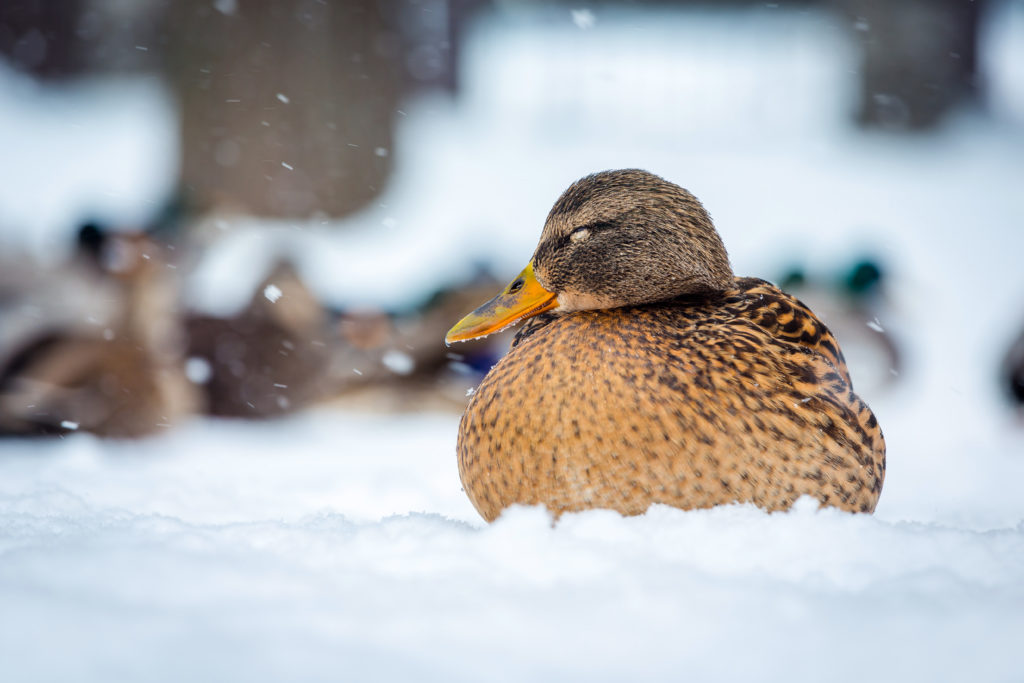
Ducks will snuggle into the snow with their feet tucked into their feathers. (Getty Images)
Vermin Proofing Your Coop
When the nights get longer and easy food sources dry up, you might see an uptick in rodents eyeballing your coop. You want to keep mice, rats, and other vermin out of your duck house. Not only do they carry diseases, they can also damage your coop and eat your eggs, and they’re just a nuisance.
Rats will ransack any feeders or feed bags they can reach, and might even hunt for smaller ducks or ducklings as an easy meal. Now is the time to ensure your coop is super secure! (If you’re worried about other predators, you can read this article about protecting ducks from larger predators.)
Rats are always a concern around coops, but particularly in the cooler weather when they start looking for a nice, warm place to nest. Prevent rats by cleaning your coop regularly, using rat-proof feeders, and making sure there are no small nooks and crannies in which they can build a nest. This last tip is especially important!
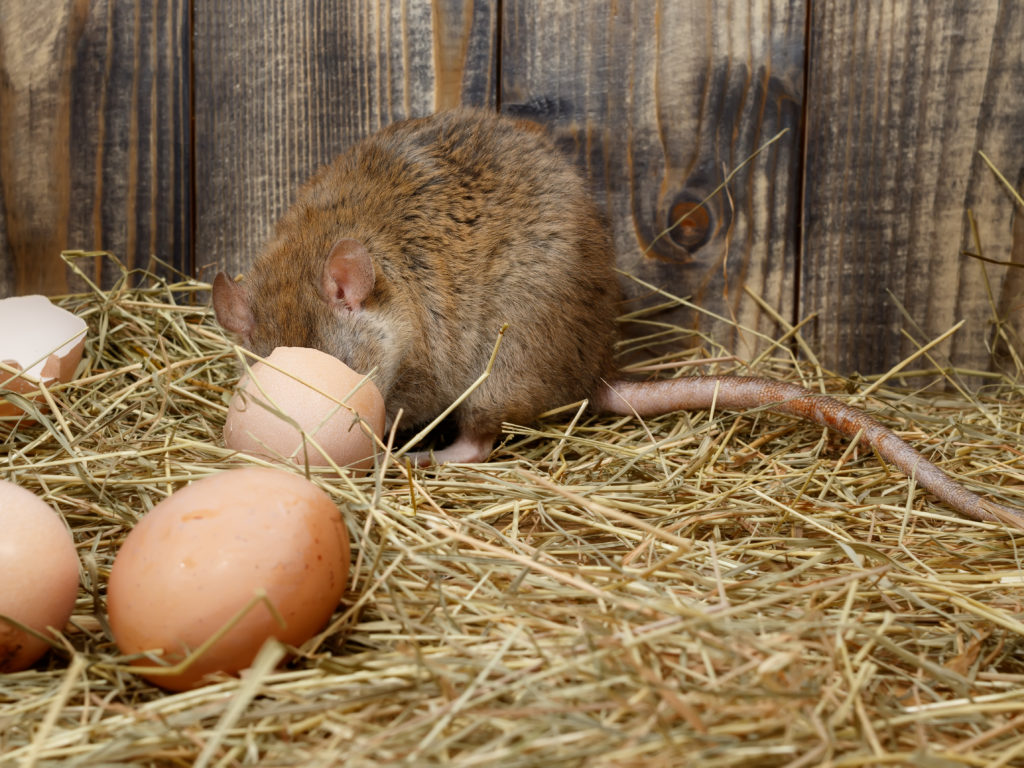
Rats will go for duck and chicken eggs, as well as chicken feed. (Getty Images)
One winter, we stored hay in our coop. We thought it was a great idea! Our flock had a nice warm place to spend the night, it kept the coop draft free, the ducks could easily sleep off the ground, and since we stored the hay on pallets, it prevented our horse hay from molding. We never saw any rats, and the coop was shut tight every night.
Well, when we moved all the hay out the following spring, a rat quickly scurried out! The freeloader hadn’t left the coop the entire winter, since it could eat fallen grain and drink all the water it wanted. It burrowed into one of the hay bales and went unnoticed for months. Lesson learned!
Easy Hacks For High-Protein Treats
One way to keep your ducks happy and healthy during the colder months is by providing high-protein treats and feed. As you probably know, birds use more calories in the winter to stay warm and keep their body temperature up.
Although ducks easily stay warm in winter due to their wonderful down feathers, there aren’t as many opportunities for them to forage for yummy bugs. When their ponds and puddle freeze, they can’t “dabble” and pick up tasty goodies that float. You need to make up those lost calories with extra meals.
Unlike chickens, ducks will try to eat at night. In fact, we’ve found that our ducks are pretty active around the clock. So, we free feed our quackers using metal automatic feeders attached to the walls of their coop. Rats can’t climb into the feeders, and they’re set just below our flock’s eye level so the ducks can easily reach them.
To increase your flock’s protein intake, you can include a high-protein additive to their feed, such as non-GMO soybean meal or even pumpkin or hemp seeds. In the fall, pumpkins are easy to find, and ducks love the insides of gourds, so we usually crack open some pumpkins. The seeds are the first to go!
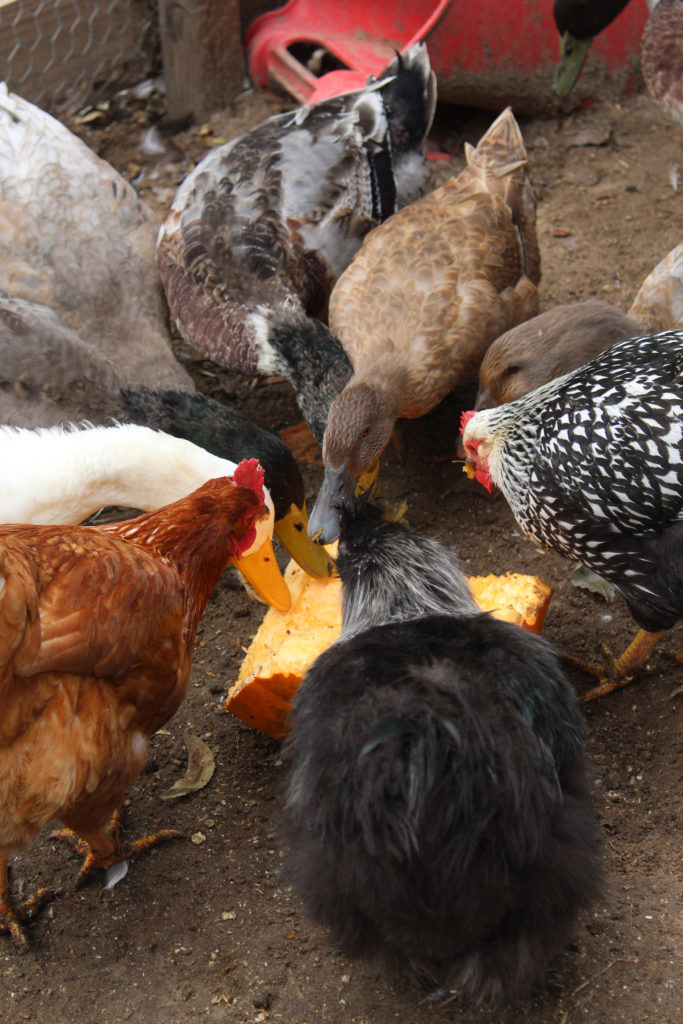
Pumpkin is always popular with backyard poultry. Photo by author.
Want eggs all winter? Unlike chickens, ducks aren’t as effected by the shorter days. So, if you notice your flock isn’t laying eggs regularly, their diet might be the culprit.
Try scrambling eggs for them (make sure they’re completely cooled), or add black soldier fly larvae to their daily ration. In the past, we’ve offered our flock a cup of scrambled eggs or black soldier fly larvae per duck, and they’ve gobbled them right up, with lots of loud, happy quacks!
Stop Moisture In Its Tracks!
In my opinion, ducks are far messier than chickens, especially since their favorite pastime is playing in water. Although it can be gloomy outside when it’s cold, make sure you still clean your coop regularly during the fall and winter months to cut down on any bacteria, mold, or other nasties that can affect the health of your flock. Your web-footed friends will appreciate it!
As the nights get longer, your ducks will likely spend more time in their coop, grooming, sleeping, eating, and pooping. That dung can build up, until it creates an overly moist environment, ripe with bacteria and fungus. Your ducks will then breathe it all in, which can lead to respiratory infections.
When cleaning your coop, you can use a commercial cleaner containing zeolite or lime, which will soak up and neutralize any excess moisture. If you want to make your own cleaner, you can mix equal parts of baking soda and flour. Sprinkle the mixture on the floor of your coop, allow it to soak up any gunk for a minute or two, and then sweep it up. Then, add your shavings as normal. Avoid any chemicals, such as bleach, which can interact with the ammonia in duck poop and develop a poisonous gas.
Keeping your coop clean will also prevent rats and mice from making the coop their home, and it’ll also help keep the bug population down.
Icy Days Mean Chilly Feet & Frostbite
Sometimes, I wonder about ducks. Even in subzero temperatures, they’ll want to play in water! Every winter, my flock protests very loudly if their water freezes and they can’t splash and clean themselves. But while ducks need fresh water to drink, water means moisture, and in cold weather, moisture can mean frostbite.
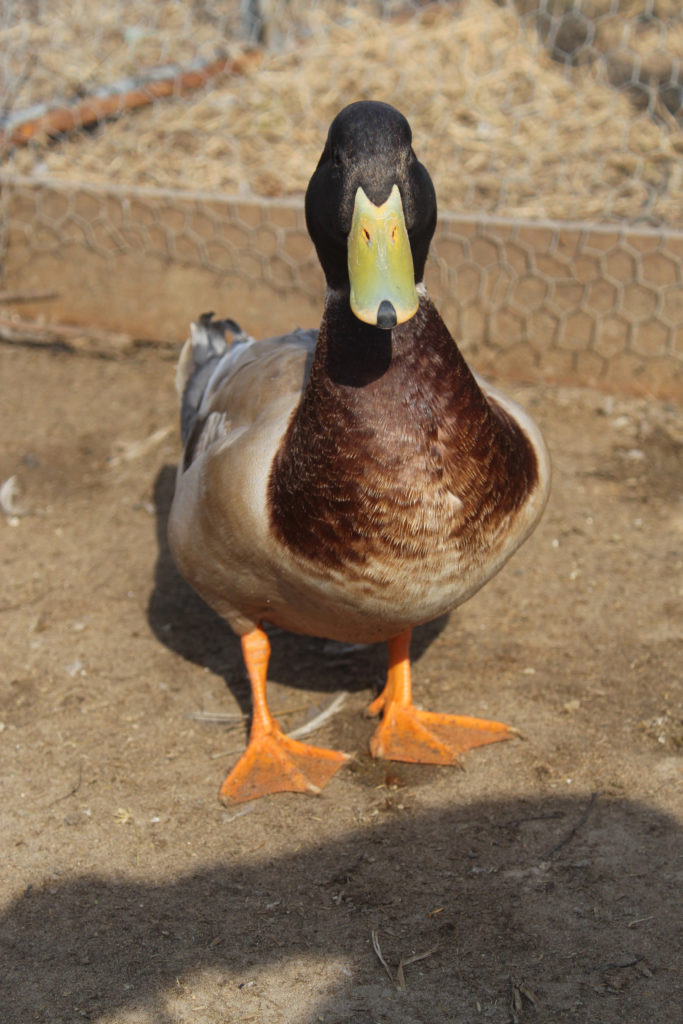
Duck with bare feet on the frozen ground. Photo by author.
If you’re not sure how frostbite can affect fowl, it’s pretty straightforward. The exposed skin can become so cold that it freezes. Potentially, that skin can die. Chickens can lose combs, wattles, and/or toes. Ducks can lose a portion of their foot, or even the entire limb in extreme cases. At a minimum, their skin can sustain an injury that might take months to recover from.
Additionally, you might notice small cuts and scrapes on their feet if they step on shards of ice. Since there’s no grass to protect their feet, they’re also more likely to scrape a foot on rocks or other sharp objects. These cuts can quickly turn into bumblefoot or another type of dangerous abscess.
Should you let your ducks play in water during the colder months? Well, I’m not sure you can stop them! What you can do, though, is offer warm, dry places for them to rest.
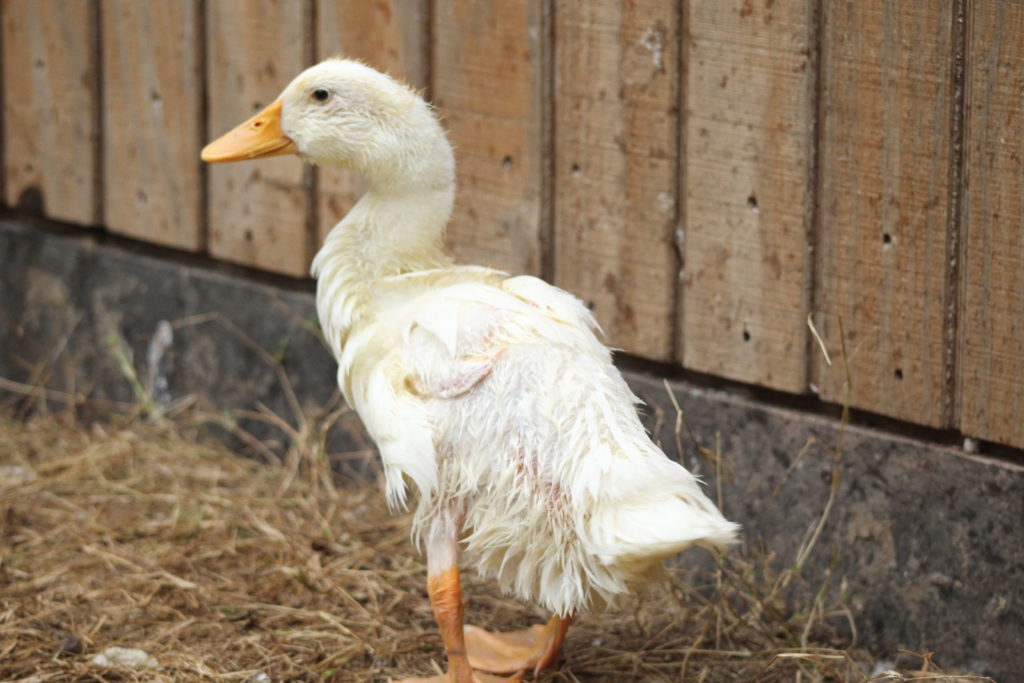
Ducks love water even when it’s cold and gloomy outside. Photo by author.
To further protect your ducks’ feet from frostbite, try smearing petroleum jelly on their webs (if they’ll let you) as a wetness barrier. It’s also a good idea to line their space with straw or rubber mats to protect their feet from potentially damaging rocks and sticks.
Stop Stressing About Inclement Weather
Now is the time to create a plan for freezing rain, which is far more dangerous to backyard fowl than snow. Freezing rain means wet feathers, which then stick to your duck’s body and freeze, making it difficult for our fluffy friends to retain their body heat.
I know from experience how stressful last-minute preparations can be. One winter, we had a sudden ice storm and had to act quickly to cover our flock’s run because our turkey, Gru, refused to stay in his coop, and instead stood out in the sleet, shivering!
You can put a tarp over their run, or lock them in their coop on days when it’s sleeting. Make sure any coop windows are closed. Have feeders and waterers easily accessible and extra bedding available. Stock up on extra treats to keep them healthy and entertained.
Have a plan in place for cleaning out the coop when there are heavy snows. You don’t want to hermetically seal your birds off from the weather, just provide them with a warm, dry place to rest and feed.
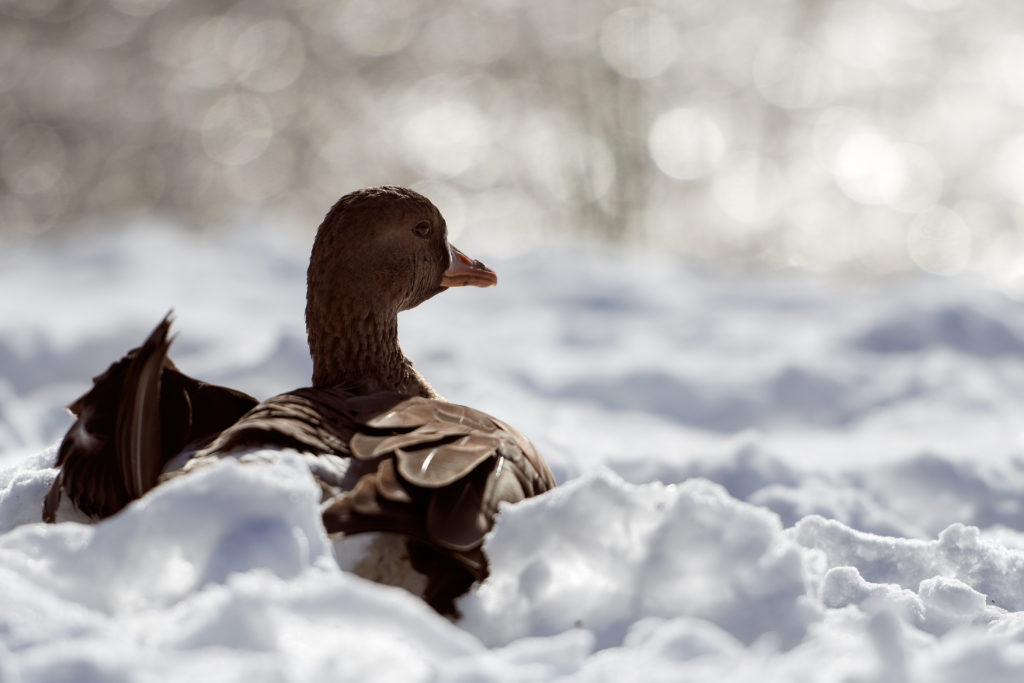
Developing a plan now means you don’t have to make last-minute decisions on the fly, adding stress to an already difficult situation.
Avoid Heat Lamps
Some might disagree with me, but try to avoid heat lamps in your duck coop during the winter. In most cases, fully feathered ducks do well in the cold weather because of their down. So, a heat lamp isn’t needed.
Heat lamps can easily ignite hay, shavings, feathers, or even fallen feed. As an alternative, to keep your flock warm on chilly nights, consider covering the coop’s floor with straw. Because the stems are hollow, they retain an air buffer, which acts as an adequate barrier against drafts and wind.
Your ducks will lay on their feet and huddle together in their coop, and the straw will insulate them and help keep their webbed toes warm. If you’re still concerned, you can offer them an extra high-protein treat, such as dried mealworms, and high-carbohydrate treat, such as cracked corn, to give them calories to burn for warmth.
I hope this article gives you some ideas on how to keep your duck flock healthy and happy when the temperatures drop this fall! What’s your best fall preparation tip?
Maat van Uitert is the founder of the backyard chicken and duck blog, Pampered Chicken Mama, which reaches about 20 million backyard poultry enthusiasts every month. She’s also the founder of the store Living The Good Life With Backyard Chickens, which carries nesting herbs, feed, and treats for chickens and ducks. You can catch up with her on Facebook and Instagram .












